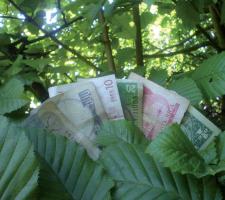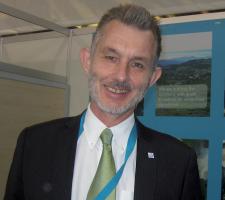
RSSBiodiversity is firmly on the agenda for 2010 with it being the International Year of Biodiversity. Claire Symes spoke to
Biodiversity has become a commonly used term within the European quarrying industry over the last decade or so, but for one organisation the history stretches back much further. The International Union for Conservation of Nature (IUCN) has been working to conserve the integrity and diversity of nature for over 60 years and is now working closely with the aggregates sector.
This year brings together several initiatives from IUCN which firmly puts the focus on nature - 2010 is the International Year of Biodiversity and also the culmination of Countdown 2010. Both initiatives offer Europe's quarry operators the opportunity to find practical ways to improve biodiversity at their sites and IUCN hopes to build on this platform in years to come.
"Aggregates have a direct impact on the landscape and nature so the quarry operators are an obvious partner for us," said IUCN pan-European regional director Hans Friederich. "The industry has shown that it is far-sighted and is working with nature and taking action to improve things." It is through Countdown 2010 that IUCN has become more closely involved with the industry.
The Countdown 2010 initiative was launched during the Irish presidency of the EU in 2004 and was aimed at mobilising local action on biodiversity with a view to halting biodiversity loss by 2010. It started in Europe but was expanded to become an international initiative. Its secretariat is hosted by IUCN.
"Countdown 2010 gave us an opportunity to engage with partners that are not IUCN members," said Friederich. "We have 1000 partners comprising local authorities and city councils as well as businesses. The initiative was born out of a political vision to halt biodiversity loss.
"Some companies have put information on the web, others have changed practices on the ground or implemented new policy. The initiative has created interaction between the partners through the web and the annual meeting that allowed knowledge and ideas to be shared. Countdown 2010's website also showcases examples of projects to demonstrate what can be achieved." The industries involved cover a wide spectrum from food and electronics through to construction and quarrying.
"The aggregates industry became involved at an early stage with the
Direct approach
IUCN has also been working directly with
"The way we are working with Holcim is the life cycle approach where we are looking at everything from planning right through to restoration. Through the project we have looked at 25 Holcim sites and the management system that has been proposed will be built into the operation to make it an integral part of the business.
"By looking at the life cycle of a quarry and focusing on the end of the lifespan and the restoration it is possible to restore land to a semi-natural habitat and to improve the biodiversity." According to Friederich, the world has not achieved its global target of halting biodiversity loss. "Yet the Countdown 2010 initiative has successfully brought the partners together and raised awareness so there is a higher recognition of the need for continued action going forward," he said.
There will not be a new Countdown project as such but a number of spin-off initiatives. There will be a new global initiative that will be launched by IUCN at the 10th Conference of the Parties to the Convention on Biological Diversity in Japan in October. In Europe Friederich said that IUCN will continue to work with its partners to build on what the platform Countdown has created and provide continued advice and support.
Visionary plans
Friederich describes IUCN as a federation of organisations. "It is a hybrid organisation," he explained. "Members include state members - we are involved with 80 governments and 115 government agencies - as well as 843 non-governmental organisations (NGOs), such as Wetlands International and Conservation International and the national WWF organisations. But we also connect with some of the smaller, more local NGOs too." IUCN was created in 1948 and is the oldest international nature organisation. The idea came from discussion on governmental approach to conservation and the lack of input of NGOs to this - IUCN links the two together.
"The development of IUCN was visionary at the time and started with a meeting in France under the auspices of UNESCO," he said. "It was originally called the International Union for the Protection of Nature but the title was changed to reflect the involvement of humans in the process." The organisation is funded in a number of different ways. "Most of the funds come from government channels and we are very proud to have framework agreements with nine countries and one Swiss Foundation for long-term funding," he said. "We also attract programme and project support as well as private and business donations."
Career development
Friederich studied Geography in his native Netherlands before travelling to the UK to complete an MSc and PhD at Bristol University in limestone hydrology. "I was always fascinated by limestone caves," he said. This passion for limestone and karst landscapes is still important to him but his involvement with that study and his current work with European quarry operators has taken him full circle.
"In my studies I often worked with limestone quarries looking at their impact on the groundwater," he said. "It is very clear to me that the industry's practices have advanced a long way since I first came into contact with it.
"It is the involvement with Holcim that really underlines this for me - it is not just a CSR director that is involved but the people that make the company tick are involved and on board." Friederich joined IUCN in 1989. "I was working in Botswana when I first heard of IUCN," said Friederich. "I liked the concept of making the link between governments and NGOs - combining the need for conservation with the ability to influence policy.
"It appealed to my sense of doing what is right for the environment and honing this knowledge through having a foot on the ground but with the possibility for global impact.
"I never viewed joining IUCN as a short-term assignment and I have been lucky with my 21 year career here to have worked in many different fields and regions with posts in Africa, Vietnam and Asia." He describes one of the highlights of his career as a time towards the end of a five year post in Vietnam as the senior technical advisor to the National Environment Agency of Vietnam and the first IUCN country director. "I handed over the post to a Vietnamese-born colleague but was asked to stay in the building for a presentation but I had no idea what it was," he said. In fact Friederich became the first foreigner to be decorated with the Medal for Science and Technology, for services to environmental protection. "That was a real honour," he said. "But it was not just a recognition of me - it was also a recognition of the support offered by IUCN."
Friederich firmly believes that the different facets of his work with IUCN are helping him in his current role to understand the challenges facing the organisation and its partners. "In Europe, the technical skills and institutional and governmental skills we have are fantastic," he said.
"My remit for Europe covers all of the EU as well as those countries looking to join, plus the CIS and Russia. It is in these regions where there is more challenge where, perhaps, the thinking is not quite at the same stage as in Western Europe." Friederich started his current role in September 2009 and before that worked directly with IUCN's partners and donors. "This is a very exciting time to take on my new role - 2010 is the International Year of Biodiversity," he explained.
Friederich is based in Gland, Switzerland but is responsible for various IUCN offices around Europe including Belgrade, Moscow, Tbilisi and Brussels. "Our Brussels office now focuses solely on working with the EU," said Friederich. "The EU is very positive on the biodiversity issue and having an office there to direct our work with the EU is very important. The main office of IUCN is now the Swiss base and we are in the process of opening a platinum standard LEED building for staff here.
Friederich has said that the first six months of his work have involved meeting with the new
"We have also been planning a number of conferences as these provide the mechanism for tell the story of biodiversity and highlight the success stories and practical results that can be achieved."RSS
















